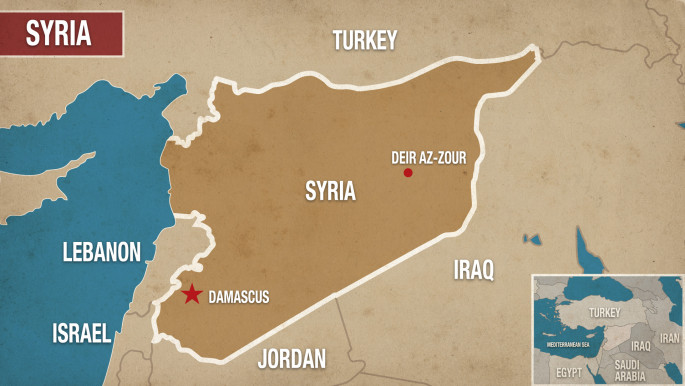Damascus puts Kurdish-led militia on notice
This month two separate campaigns carried out by the Russian-backed Syrian Arab Army of President Bashar al-Assad, and the United States-backed Kurdish-led Syrian Democratic Forces made serious headway against the Islamic State group in the eastern Syrian province of Deir az-Zour.
But these forces are not allied, and war may well break out between them.
Assad's SAA successfully broke the lengthy IS siege on Deir az-Zour, with support from Russian aircraft and even ship-launched cruise missiles.
Shortly thereafter, the Kurdish-led SDF began to advance further into Deir az-Zour province from the north, and quickly made it to the east bank of the Euphrates River there.
Both forces are now mere miles away from each other. The SDF has declared the natural boundary provided by the Euphrates as the dividing line between them and the SAA.
The US has supported this stance, arguing the line "parallel to the Euphrates River" is adequate for allotting the two forces separate areas of responsibility to fight IS.
 |
Most wells are just north of the Euphrates. It now seems that the SDF, with US backing, wants that oil |  |
The latest violence between the two came on Monday, September 25, with Russian airstrikes and mortar fire targeting Deir az-Zour's giant Conoco gas plant - just days after the SDF captured it from the Islamic State group. Six were injured, and details of the attack are still emerging at time of writing, but tensions are likely to escalate, with an SDF spokesperson saying the Kurdish-led militia "reserved the right to respond".
 |
|
| [Click to enlarge] |
Read more: US-backed Syria militia 'hit by Russian bombing'
On September 18, SAA forces crossed to the SDF's side of the Euphrates, using Russian equipment, giving the regime a foothold there.
"If there are clashes between us and them - we're ready for those if the forces of the regime don't go back to the other bank," declared SDF official Ahmed Abu Khawla.
Professor Joshua Landis, of the University of Oklahoma, said both groups were heading for oil-rich territories.
"Both the Syrian army and the SDF are making a play for the Euphrates Valley, where a great deal of Syria's oil is situated," he told The New Arab. "Most wells are just north of the Euphrates. It now seems that the SDF, with US backing, wants that oil."
Control over this oil gives the SDF a source of revenue for its semi-autonomous - and unrecognised - federal democratic polity in the Syrian Kurdish territories, and other territories they've captured from IS where they have established military councils, such as Manbij.
 |
| Much of Deir az-Zour has been destroyed in the six-year war [AFP] |
The SDF plans to implement additional military councils in Raqqa and swathes of Deir az-Zour after IS' ousting. But the Syrian regime is unlikely to willingly leave the country's only real valuable natural resources under SDF control.
An SDF position on the northern side of the Euphrates in Deir az-Zour was bombed on September 16 with Russian munitions, according to the US-led anti-IS coalition, injuring SDF fighters.
"Syrian authorities have said they will eventually go to war against the SDF, perhaps not today, but they will not allow Syria to be divided," Landis added. "This could be war.
"The Syrians are putting the SDF on notice. This most recent bombing is likely a shot across the bow of the SDF and the Americans."
 |
If the US abandons the SDF, the US will be accused of abandoning the Arabs to Bashar [al-Assad], the murderer and chemical weapon user |  |
Any Russian-Syrian targeting of the SDF in that region also runs the risk of killing American troops. Russia has previously targeted US allied forces. In June 2016 they bombed the US-backed Jaysh Maghawir al-Thawra (formerly known as the New Syrian Army), an anti-IS group at its base in Al-Tanf, on the Jordanian border.
The attack, which Moscow said was an accident, came shortly after US-led coalition personnel left the base, indicating that Russia wanted to send a message without directly harming US or coalition military personnel.
This June, the United States shot down a Syrian Air Force Su-22 jet near Tabqa, alleging that it had targeted their SDF allies fighting IS.
US troops regularly embed with the SDF on offensives in supporting roles. The September 16 attack hit near their positions, "at most a couple of miles" away, a US official told CNN. No US troops were harmed.
But it remains unclear if the strike was deliberate. It was, nevertheless, an indication of what is at stake.
It is a possibility, Landis said, that the SDF may be simply seizing this territory to use as a bargaining chip with the regime and the Russians, perhaps to relinquish them in return for some recognition of their federal region in the Kurdish-majority territories of northern Syria.
"[But] once the SDF owns it and places Arab tribes in quasi-charge of it under US oversight, it will be very hard to let go.
"The US seems to be backing up the SDF in this campaign, which will make it very hard to back away from," Landis said. "If the US abandons the SDF, the US will be accused of abandoning the Arabs to Bashar [al-Assad], the murderer and chemical weapon user.
"Once they [the SDF] take it and spend blood to establish order, giving it up will be very hard."
Paul Iddon is a freelance journalist based in Erbil, Iraqi Kurdistan, who writes about Middle East affairs.
Follow him on Twitter: @pauliddon



